Why you can trust TechRadar
We spend hours testing every product or service we review, so you can be sure you’re buying the best. Find out more about how we test.
TerraMaster F4: 30-second review
Terramaster has effectively carved out a niche in the NAS world with a combination of well-constructed hardware that supports a feature-rich environment and is aggressively priced.
As a result, it has attracted many home and small business customers who wouldn’t pay Synology, Asustor, or QNAP prices, but wanted solid equipment to manage and distribute data.
The F4 SSD isn’t the first SSD-based NAS that TerraMaster has produced, but it immediately stands out as something distinctly mainstream, significantly cheaper than the majority of products in this sector.
This small box can mount four PCIe Gen 3 NVMe drives, providing a total capacity of 32TB, and then distribute them over the network using a 5GbE LAN port.
The core of this solution is an Intel N85 processor, and it comes with 8GB of DDR5 memory, which is easily upgradable to 32GB by the user.
It utilises TerraMaster’s own TOS 6.0 operating system, although you don’t invalidate your hardware warranty if you use a third-party NAS OS, such as TrueNAS SCALE, Proxmox, etc.
With all this flexibility for a modest price, what’s the catch here?
The issue with this system is that the CPU’s power is on the low side, and therefore, it wouldn’t be ideal for running multiple simultaneous applications, Docker containers, or virtual machines.
At best, this hardware is best for primary tasks with perhaps a secondary role, but accept that file serving will take much of the power in this machine.
However, even with those limitations, this is a neat and helpful platform for those who want a tiny, silent and efficient NAS solution.
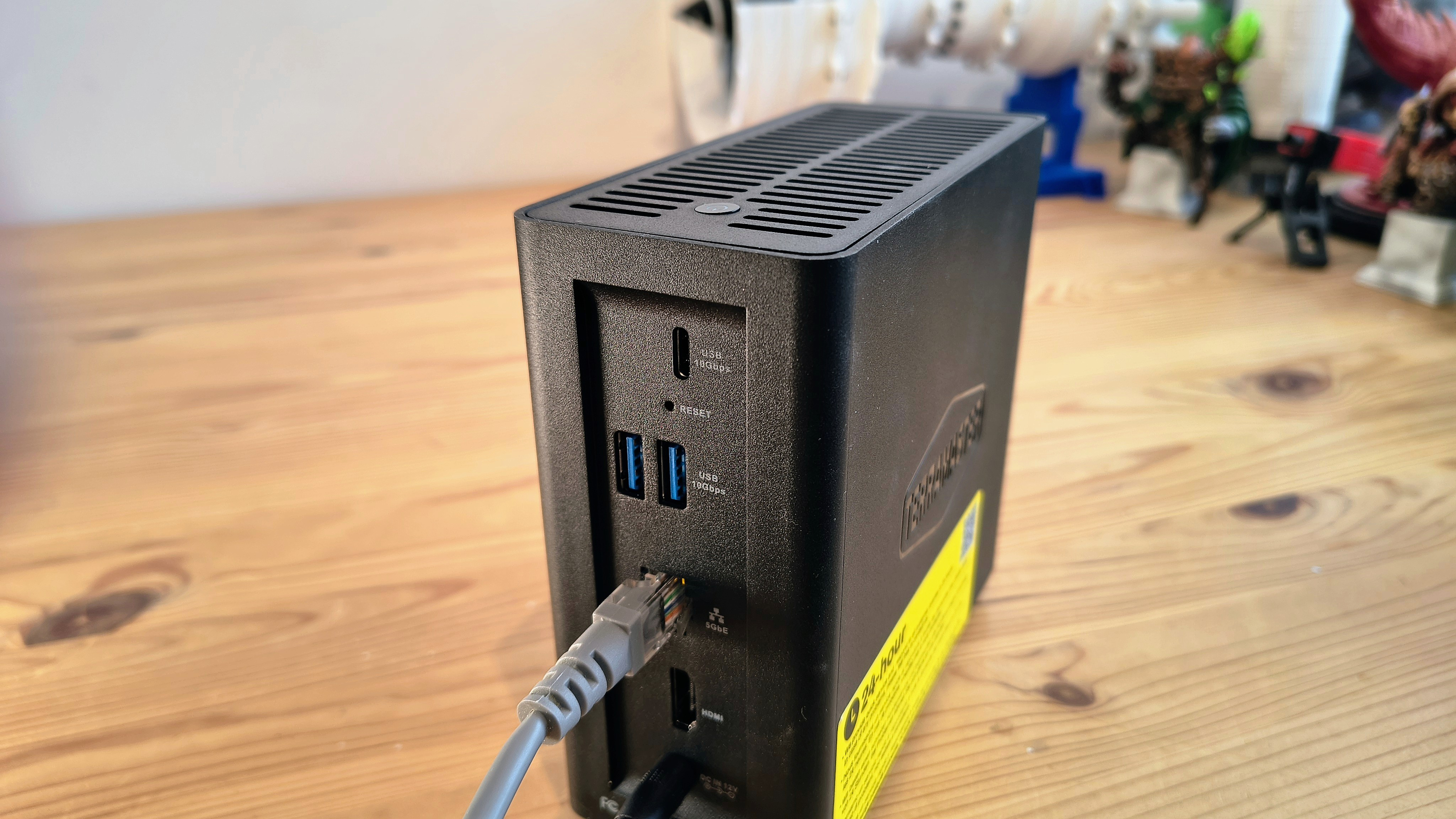
TerraMaster F4: Price and availability
- How much does it cost? From $400/£380
- When is it out? Available now
- Where can you get it? Direct from the makers or through an online retailer
Unlike some brands, TerraMaster is widely available and also sells its hardware directly from its website.
The asking price for the only available SKU is $399.99 on Amazon in the United States and £379.99 on Amazon in the United Kingdom. That’s $200 less than the larger F8 model, and half the price of the F8 Plus.
That’s dramatically cheaper than the Ugreen NASync DXP480T, which costs about double this and still only takes four NVMe drives. However, that machine has a much more powerful i5 platform, a 10GbE LAN port and Thunderbolt.
The Asustor Flashstor 6 FS6706T is slightly more expensive, offering a six-drive option with increased processing power and dual 2.5GbE LAN ports, but it comes with only 4GB of memory.
Closer to the Ugreen option in price is the QNAP TBS-464-8G for $589.99 from Amazon, powered by the Intel Celeron N5105/N5095. The downside of that option is, other than the price, that the 8GB of RAM is not upgradable.
However, not all competitor devices are sold as NAS. One competitive alternative is the Minisforum MS-01-S1260 Mini Workstation, a mini PC that utilises the Core i5-12600H processor, supports three M.2 2280 drives, and features dual 2.5GbE LAN ports and USB4.
In a barebones configuration where the customer must provide an operating system, RAM, and storage, the MS-01-S1260 can be purchased for just $399.99 on Amazon, and there are SKUs that feature more powerful Core i9 CPUs.
Excluding mini-computers overlapping NAS territory, the TerraMaster F4 is the cheapest mainstream branded SSD NAS around, and represents excellent value for money.
But, only if the use case doesn’t require significant amounts of processing power.
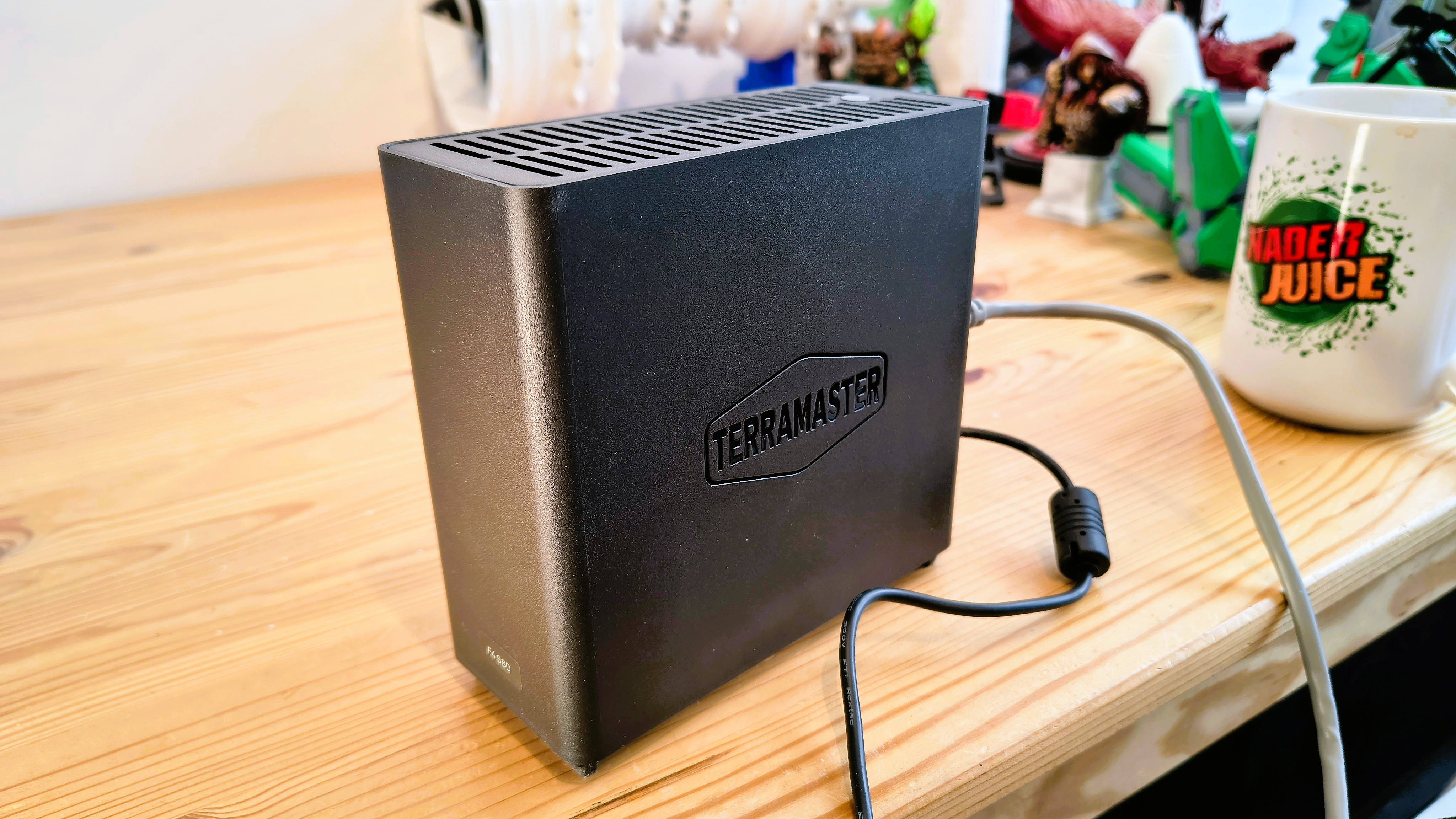
TerraMaster F4: Specs
|
Item |
Spec |
|---|---|
|
CPU: |
Intel N95 (4 cores, 4 Threads) |
|
GPU: |
Intel Graphics (16EU) |
|
RAM: |
8GB DDR5 expandable to 32GB |
|
SATA Storage: |
N/A |
|
M.2 Storage: |
4x M.2 NVMe PCIe 3.0 |
|
Ports: |
2x USB3.2 Gen2 USB-A (10Gbps) |
| Row 6 – Cell 0 |
1x USB3.2 Gen2 USB-C (10Gbps) |
| Row 7 – Cell 0 |
1x HDMI 2.0b |
|
Networking: |
1x RJ45 5GbE LAN |
|
OS: |
TOS 6.0 |
|
Maximum Capacity: |
4x 8TB M.2 NVMe (32TB) |
|
RAID Modes: |
TRAID, TRAID?, Single, JBOD, RAID 0, RAID 1, RAID5, RAID 6, RAID 10 |
|
PSU: |
12V 4A 48W |
|
Dimensions: |
138 x 60 x 140 mm (LxWxH) |
|
Weight: |
600g |
TerraMaster F4: Design
- Chimney layout
- Easy access
- Simple and silent
The design and layout of this machine seem vaguely familiar, as it employs a concept similar to that of the Beelink Me mini system I recently reviewed.
What they share is a cooling solution where the case acts as a chimney, drawing cool air from below, gathering heat as it rises over the motherboard and M.2 storage before being expelled out of the top.
In the F4, the air is propelled by two almost silent 50mm fans on the bottom, and the book-like form factor is arranged with the M.2 slots on one side and the processor and memory on the other.
What’s slightly different is that the front face of the unit, where it says TerraMaster F4, is clearly not the end that should be facing you. As all the ports and the power button are at the opposite end, which is the rear.
What’s great about this unit over some other NAS is how easy it is to get inside to add drives and upgrade memory. A single thumbscrew on the rear releases the outer skin, allowing it to slide off easily.
With this plastic shell removed, the M.2 slots and the memory are available, and this doesn’t require any tools. However, TerraMaster does include a screwdriver, which is useful for those easy-to-misplace M.2 screws, and thankfully, some spares are included in the box.
I’m surprised that the designers didn’t use a sprung plastic retainer, like those on the Asustor Flashstor 6 FS6706T, as it would have made this design entirely tool-free.
According to TerraMaster, the M.2 slots are designed for up to 8TB drives, and there is sufficient room for modules with integrated heatsinks to be used. What I recommend is that if you use any double-sided modules, you should add a heatsink to them, as there’s no thermal pad connecting them to the case, which is mostly made of plastic.
For those wondering what the best drives to use are, TerraMaster has a good selection of approved brands and models in stark contrast to the own-brand path that Synology has recently taken.
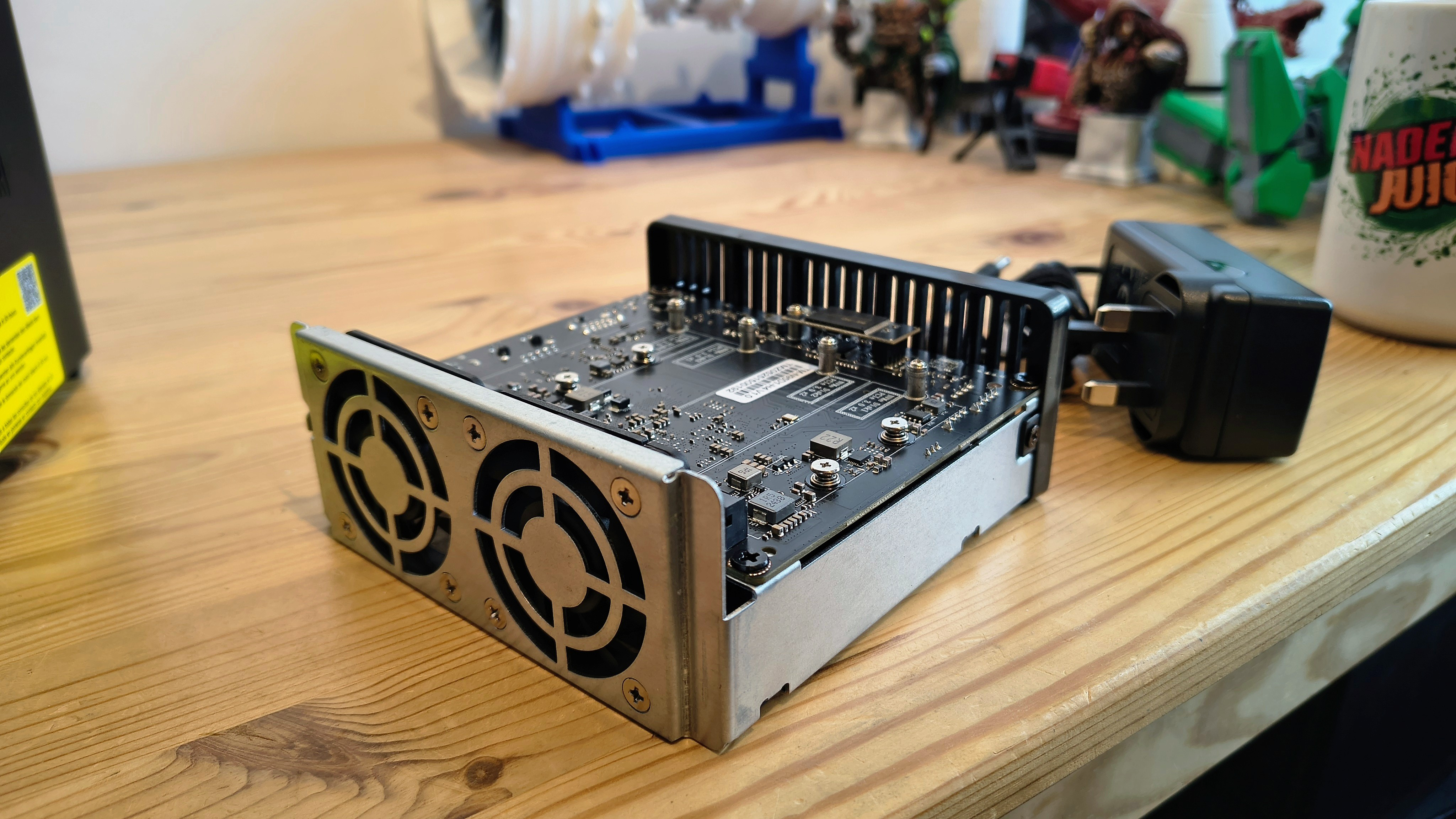
Interestingly, I used an idiosyncratic mix of brands in my testing, some of which weren’t on this list, but I didn’t have any issues. The only ones the makers suggest to avoid are S500PRO modules by Fanxiang, and that’s across all their NAS boxes that can accept M.2 modules.
The only limitation on physical size for the F4 is that all drives must be NVMe and 2280, as there are no retainer positions for 2260, 2242, or 2230 drives.
If I were deploying one of these on a budget, I’d be considering using a drive like the Crucial P3, where the 4TB model can be found for under $220. Using these, a system with 16TB of storage can be constructed for close to $ 1,200, and as SSD NAS go, that’s cheap.
The strength of this design lies in its relatively low power consumption and vertical tube topology, which make for a simple-to-deploy and nearly silent NAS.
For those who would like a small NAS to sit on their desk, perhaps to keep a live backup of a running system, the F4 is ideal in many respects.
TerraMaster F4: Features
- Intel N95 CPU
- No ECC memory
- Only 9 PCIe Lanes
When Intel first introduced the Atom series of processors, many wondered why customers would purchase such low-power systems. These days, platforms that are scaled back to run 24/7 or deliver just enough performance for the primary task are common.
The Intel N95 is where low-power computing took Intel, and it’s not anything you would ideally wish to use on a desktop computer.
While it does have an integrated GPU with sixteen execution units, this processor is more limited by its four-core CPU, which doesn’t support hyperthreading. Four cores on Windows 11 would be a nightmare, but for the custom Linux platform of TOS 6.0, it is sufficient. Additionally, with 8GB of RAM, expandable to 32GB, it is also more than enough for file-serving duties.
However, the wall and running into that barrier are never too far away with the N95, and this isn’t a system that would enjoy being pre-loaded with demanding applications. Those who put Plex on it don’t expect it to do that and also run a torrent client, a mail server and three Docker containers, because it won’t be smooth sailing.
Precisely where the N95 runs out of road entirely depends on how demanding the apps are, but if you want to run many applications, then there are alternatives that use more powerful Intel and AMD processors that will be better choices.
The other limitations of the N95 are that it can only address a single memory module and has limited PCIe Express lanes. There is only one memory channel, and thankfully, TerraMaster engineers used a DDR5 module on it to maximise bandwidth.
Intel claims it can address up to 16GB, while TerraMaster says 32GB, but whichever is correct, they both agree it doesn’t support ECC memory, unfortunately.
I believe, and this may be misinformation, that the standard memory model of the N95 allows only 16 GB. The additional 16GB of memory can be used for things like virtual machines.
If you don’t intend to use VMs, then putting more than 16GB in the F4 is probably pointless.
Even 16GB is a good amount of memory for a small server, especially when you consider that the drives in this unit don’t require much caching to perform well.
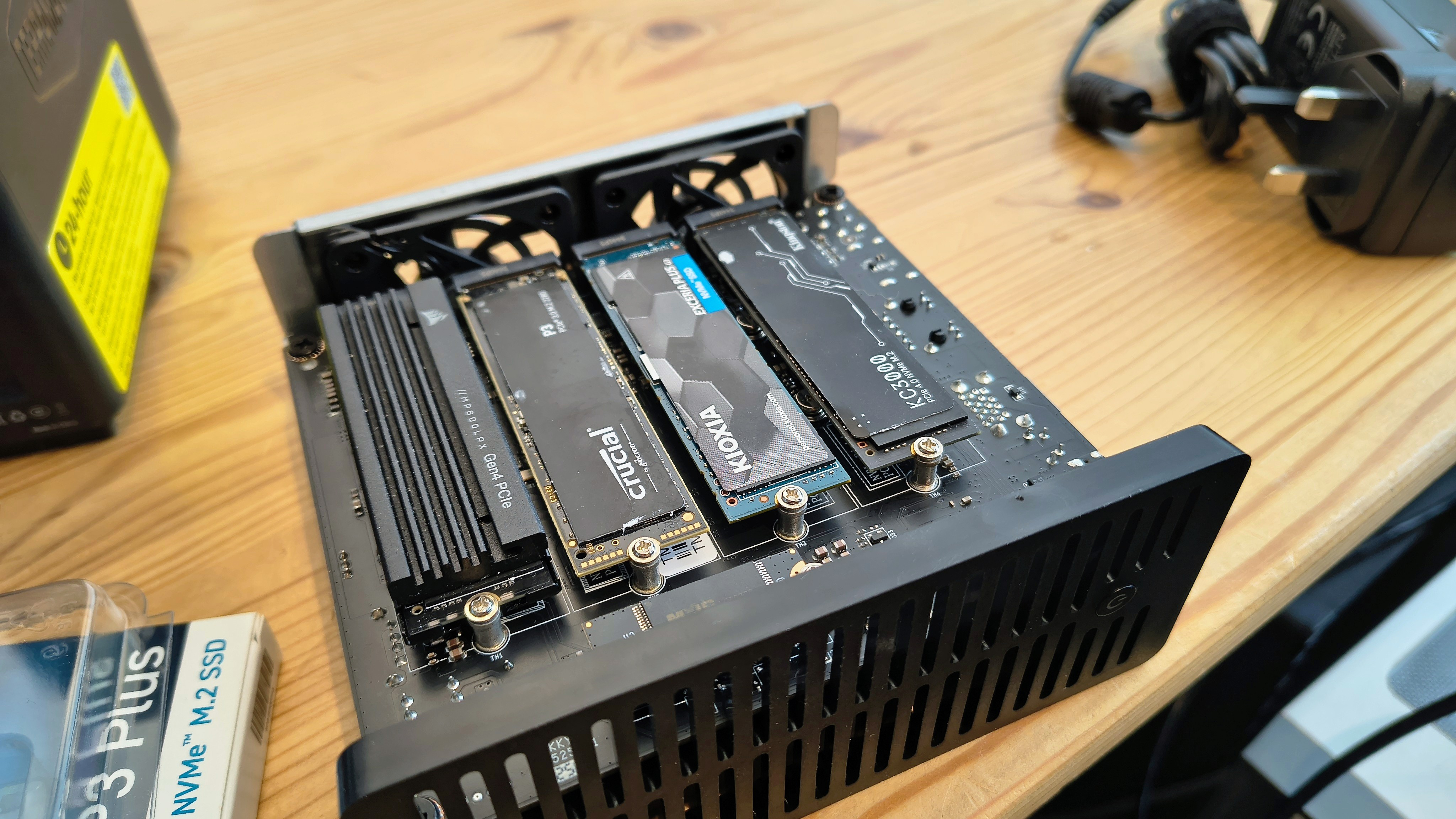
A bigger issue is the PCIe lanes, since these dictate exactly how much data can flow through the system and to externally connected devices.
With only nine PCIe 3.0 lanes, there isn’t enough bandwidth for the SSDs to have the full X4 lanes that modern NVMe drives are designed for. Two of the slots have been downgraded to X2, while the other two remain at X1. Therefore, it’s a futile exercise to populate these slots with modules meant for PCIe 4.0, since they will be downgraded to PCIe 3.0 by the system.
Being pragmatic, achieving 1GB/s from two drives and possibly 2GB/s from two others is still well beyond the performance required to saturate the 5GB/s of the single LAN port fully.
As there were no PCIe lanes left to add a card slot, the only way to get more network bandwidth is by using USB adapters. There are relatively inexpensive 5GbE adapters that can utilise USB 3.2 Gen 2 ports, but I cannot personally confirm whether they would work on this platform.
Again, if you want better than a single 5GbE LAN connection and more PCIe lanes for faster drives, then this probably isn’t the NAS for you.
Overall, the F4 makes the most of its hardware, but this machine won’t break any records for having excess performance on tap or for its responsiveness.
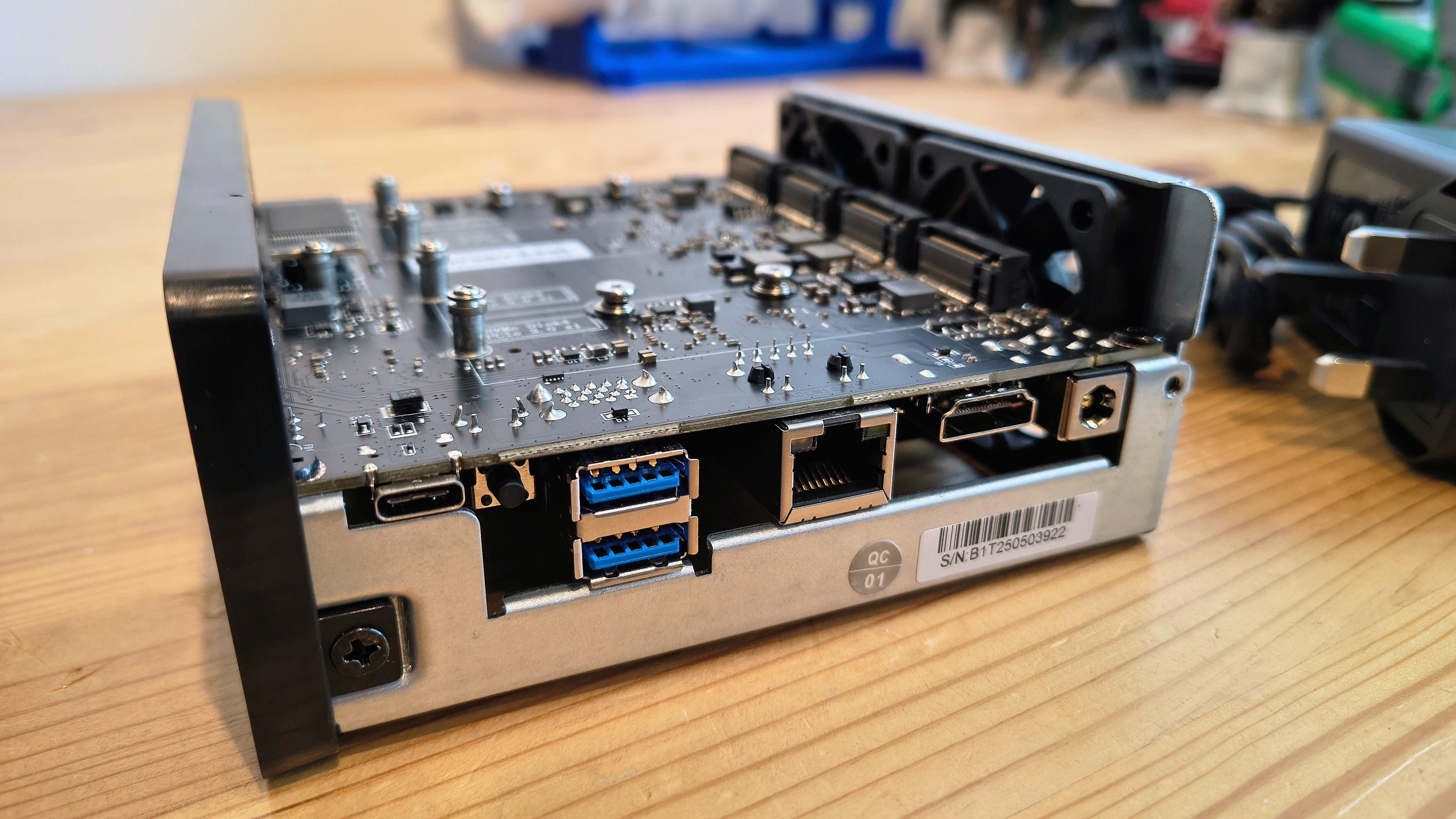
TerraMaster F4: Software
- TOS 6.0
- Applications
- Yes to TrueNAS and UnRaid
For those who started with TerraMaster early on, and I’m happy to say that includes me, the evolution of the TerraMaster OS, or TOS, has been impressive.
Now in its sixth incarnation, this is a pretty mature platform that offers a wide range of functionality and applications.
While it doesn’t quite reach the levels of polish that Synology prides itself on, the feature set of TOS 6.0 ticks plenty of boxes.
One interesting change of direction that TerraMaster isn’t unique in taking is a shift away from first-party applications to those that are installed either as Docker-packaged containers or as virtual machines. Some compiled TOS apps, such as Qtorrent and Plex, are available on the TerraMaster application store. However, you can install later versions of these tools by finding the Docker container and using it instead.
While TerraMaster isn’t competing with the likes of QNAP and Synology for the number of available apps on its platform, there is more than enough for the majority of customers, and it isn’t a closed environment that requires approved tools.
TOS 6.0 isn’t for everyone, but TerraMaster is one of those NAS makers that is entirely customer-focused and is happy for their hardware to be used with TrueNAS Scale, UnRaid, Proxmox, or any other NAS OS the owner wishes. You won’t receive software support from TerraMaster if you opt for this approach, but hardware issues are still covered during the warranty period.
It’s interesting to see that TerraMaster and Ugreen are both pitching the ‘NAS-your-way’ approach, whereas other brands seem less confident about allowing alternatives into their playgrounds. This direction appears opposed to where Synology is heading, where the turnkey solution comes with much stricter limits on what you can and can’t do.
This is certainly more customer-friendly, but will it lead to a future where NAS makers no longer bother with a branded OS and instead offer a pre-loading service of a popular third-party OS? Only time will tell.
In short, TOS 6.0 offers a plethora of features that cover the majority of tasks that NAS commonly use, and if these don’t quite match your needs, the ability to run Docker containers and VMs is a viable answer.
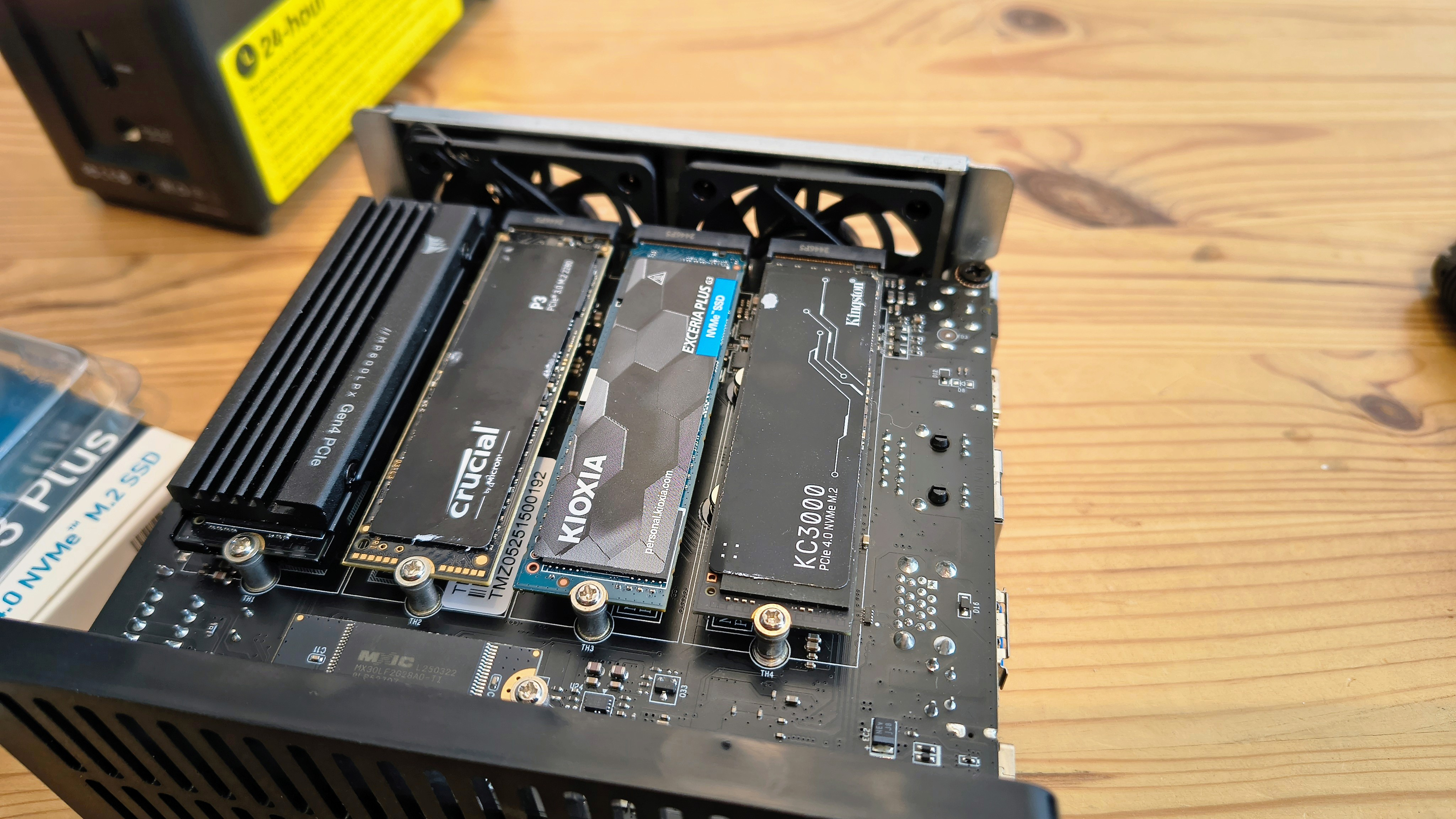
TerraMaster F4: Final verdict

There are good things about the F4, and some other things that aren’t wonderful.
Unless you kludge a NUC into a mini server, this is undoubtedly one of the most affordable SSD NAS options available. However, being realistic, the cost of the F4 is likely to be dwarfed by that of the M.2 modules unless you only install 1TB or smaller drives in it.
If you can afford to populate this with 8TB modules, or even 4TB, then you might get more performance in return by investing in an Asustor or Ugreen SSD NAS.
The other issue here is that the Intel N95 limits the system’s capabilities somewhat, as it lacks the performance to handle multiple apps or Docker containers. It also dictates that there is no USB4/Thunderbolt, which on other systems can be used to locally network to a host PC while the LAN ports support other users.
The natural space this device occupies is either as a network location for live synchronisation or as a directly connected external storage system. In both these scenarios, the 5GbE LAN port can deliver and retrieve data at over 500MB/s, making it as fast as a USB 3.2 Gen 1 attached SSD. The lure is that it can offer capacities much larger than even the biggest USB-connected SSDs, which typically only offer 8TB as their largest option.
Outside of this use, justifying the investment becomes tougher, since this doesn’t have the power to be an all-purpose NAS or the LAN connections to handle a 10GbE network.
Should I buy a TerraMaster F4?
|
Value |
Inexpensive, if you ignore the M.2 modules |
4 / 5 |
|
Design |
Elegant chiney cooling and easy access |
4 / 5 |
|
Features |
5GbE LAN, 8GB of RAM, but only a four-core CPU |
3 / 5 |
|
Software |
TOS 6 has plenty to like |
4 / 5 |
|
Overall |
Some improvements, removed features at twice the price |
4 / 5 |
Buy it if…
Don’t Buy it if…
Also Consider
For more storage solutions, we’ve reviewed the best NAS hard drives and the best NAS devices.






Leave a Comment
Your email address will not be published. Required fields are marked *